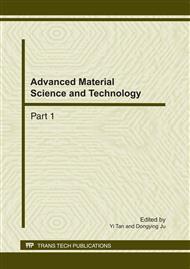p.85
p.89
p.93
p.97
p.101
p.105
p.109
p.113
p.119
Effects of Impurities Distribution on the Crystal Structure and Electrical Properties of Multi-Crystalline Silicon Ingots
Abstract:
Multi-crystalline silicon ingots were prepared by directional solidification using vacuum induction melting furnace. The content of aluminum and iron deeply decreased in the columnar crystal region of the multi-crystalline silicon ingots. The columnar crystal growth broke off corresponded to the iron contents sharply increased. The height of columnar crystal in the silicon ingots related to the pulling rates had been clarified by the constitutional supercooling theory. The maximum of the resistivity and the minority carrier lifetime closed to the transition zone where the conductive type changed from p-type to n-type in silicon ingots. Further analysis suggested that the electrical properties were related to the contents of shallow level impurities aluminum, boron and phosphorus.
Info:
Periodical:
Pages:
101-104
Citation:
Online since:
February 2011
Authors:
Price:
Сopyright:
© 2011 Trans Tech Publications Ltd. All Rights Reserved
Share:
Citation:


